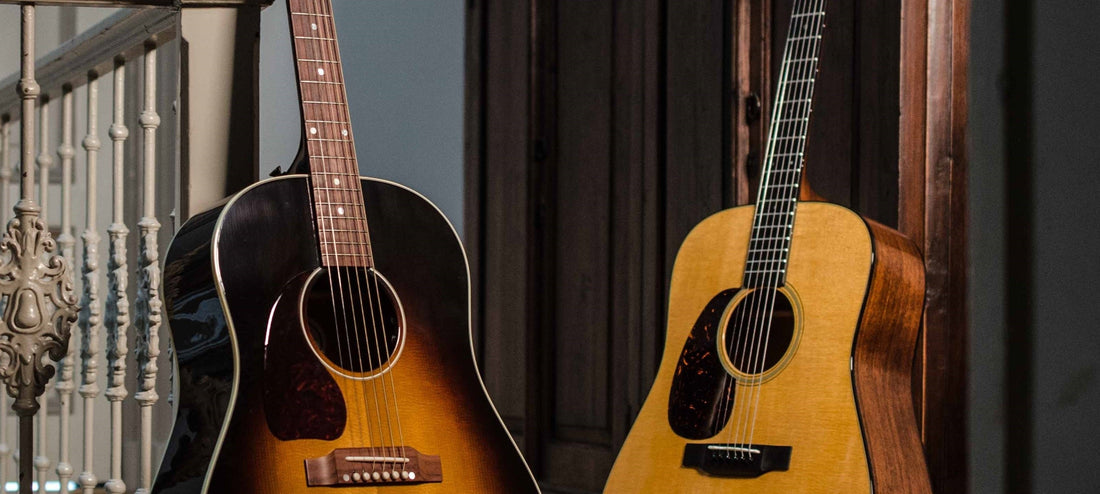
Martin D-18 vs. Gibson J-45: Which One is Right for You?
Share
Martin D-18 vs. Gibson J-45: A Classic Acoustic Showdown
If you’re in the market for a high-quality acoustic guitar, the Martin D-18 and Gibson J-45 are two of the most iconic dreadnoughts you can buy. Both have been used by legendary musicians and offer rich, professional-grade tone. However, they have distinct characteristics that might make one a better fit for you than the other. Let’s break down their differences and help you decide which one suits your needs.
1. Tonewood and Construction
Martin D-18:
• Top: Solid Sitka Spruce
• Back and Sides: Solid Mahogany
• Neck: Select Hardwood
• Bracing: Scalloped Forward-Shifted X-Bracing
The D-18 is known for its bright, clear, and articulate tone, thanks to its mahogany body. The forward-shifted scalloped bracing gives it more responsiveness, making it an excellent choice for flatpicking, bluegrass, and fingerstyle playing.
Gibson J-45:
• Top: Solid Sitka Spruce
• Back and Sides: Solid Mahogany
• Neck: Mahogany
• Bracing: Traditional Hand-Scalloped X-Bracing
The J-45, also made of spruce and mahogany, has a warmer, rounder, and more compressed tone. It’s famous for its “woody” sound and strong midrange, making it ideal for strumming and singer-songwriter performances.
2. Sound and Tone Differences
|
Feature |
Martin D-18 |
Gibson J-45 |
|
Bass Response |
Tight, punchy |
Warm, rounded |
|
Midrange |
Clear and articulate |
Strong and rich |
|
Treble |
Crisp and bright |
Smooth and mellow |
|
Projection |
Loud and powerful |
Warm and balanced |
|
Sustain |
Longer sustain |
Shorter sustain, quicker decay |
• If you love a crisp, articulate tone with excellent note separation, the D-18 is a great choice.
• If you prefer a warmer, more blended sound with a strong midrange for vocal accompaniment, the J-45 might suit you better.

3. Playability and Comfort
Neck Shape and Feel
• The Martin D-18 has a Modified Low Oval neck with a High-Performance Taper, making it fast and easy to play, especially for lead work.
• The Gibson J-45 has a Rounded C-shape neck, which is slightly chunkier but comfortable for strumming and rhythm playing.
Scale Length
• Martin D-18: 25.4 inches → More tension, better for flatpicking and lead work.
• Gibson J-45: 24.75 inches → Lower tension, making bends and chords easier to play.
If you have smaller hands or prefer easy fretting, the J-45’s shorter scale might be more comfortable. If you want more clarity and power, the D-18’s longer scale is beneficial.
4. Versatility & Musical Styles
|
Genre/Playing Style |
Martin D-18 |
Gibson J-45 |
|
Bluegrass & Flatpicking |
✅ Excellent |
❌ Less ideal |
|
Strumming & Vocal Accompaniment |
✅ Good |
✅ Excellent |
|
Fingerpicking |
✅ Crisp and detailed |
✅ Warm and expressive |
|
Blues & Folk |
✅ Versatile |
✅ Iconic |
|
Rock & Country |
✅ Bright and punchy |
✅ Smooth and warm |
• If you play bluegrass, flatpicking, or want crisp articulation, go for the Martin D-18.
• If you mainly strum, sing, and want a warm, vintage vibe, the Gibson J-45 is the way to go.
5. Price and Value
Both guitars are high-end instruments, but their pricing differs slightly. Martin D-18 is a bit more expensive, but they are considered same price range. At Guitar Heroes, we offer the best price for any guitar lovers, with great service and best after-sale support! Whatever guitars you wish, we give the best opportunities for you here.
The Martin D-18 holds its value exceptionally well among bluegrass and traditional players, while the J-45 has a strong following among singer-songwriters and folk musicians.

6. Final Advice: Which One Should You Choose?
• Pick the Martin D-18 if:
✔ You want a clear, bright, and articulate sound.
✔ You play bluegrass, flatpicking, or intricate fingerstyle.
✔ You need strong projection and note definition.
• Pick the Gibson J-45 if:
✔ You want a warm, full, and balanced tone.
✔ You primarily strum and accompany vocals.
✔ You prefer a softer feel with lower string tension.
